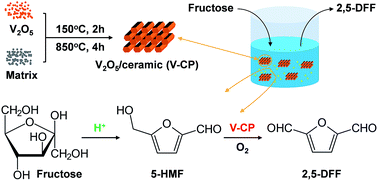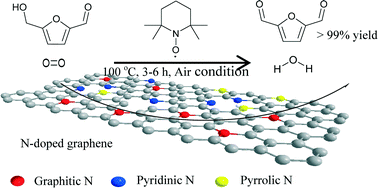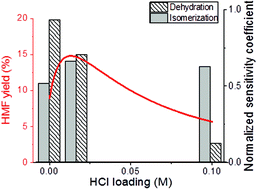
Shared posts
General Synthetic Route toward Highly Dispersed Metal Clusters Enabled by Poly(ionic liquid)s
Direct conversion of CO2 into liquid fuels with high selectivity over a bifunctional catalyst

Nature Chemistry. doi:10.1038/nchem.2794
Authors: Peng Gao, Shenggang Li, Xianni Bu, Shanshan Dang, Ziyu Liu, Hui Wang, Liangshu Zhong, Minghuang Qiu, Chengguang Yang, Jun Cai, Wei Wei & Yuhan Sun
It is still a great challenge to synthesize value-added products with two or more carbons directly from CO2. Now, a bifunctional catalyst composed of reducible metal oxides (In2O3) and zeolites (HZSM-5) is prepared and yields high selectivity to gasoline-range hydrocarbons (78.6%) with a high octane number directly from CO2 hydrogenation.
Inside Cover: A Simple and Mild Approach for the Synthesis of p-Xylene from Bio-Based 2,5-Dimethyfuran by Using Metal Triflates (ChemSusChem 11/2017)

The Inside Cover picture shows that a renewable p-xylene (PX) can be directly synthesized from biomass-derived 2,5-dimethylfuran and acrylic acid over scandium(III) triflate (Sc(OTf)3) and H3PO4 under mild conditions. A subsequent one-pot decarboxylation step results in an overall 63 % selectivity towards PC at 90 % conversion of 2,5-dimethylfuran. The production of PX is of great importance in the synthesis of bulk chemicals like terephthalic acid, which is widely used in several industrial applications. More details can be found in the Full Paper by Ni et al. on page 2394 in Issue 11, 2017 (DOI: 10.1002/cssc.201700020).
Ionic liquid/H2O-mediated synthesis of mesoporous organic polymers and their application in methylation of amines
DOI: 10.1039/C7CC01910F, Communication
Mesoporous Troger's base-functionalized organic polymers were prepared using a sulfonic acid group functionalized ionic liquid/H2O system without any templates and surfactants.
The content of this RSS Feed (c) The Royal Society of Chemistry
Charged Covalent Triazine Frameworks for CO2 Capture and Conversion
Nanobelt-arrayed vanadium oxide hierarchical microspheres as catalysts for selective oxidation of 5-hydroxymethylfurfural toward 2,5-diformylfuran
Source:Applied Catalysis B: Environmental, Volume 207
Author(s): Yibo Yan, Kaixin Li, Jun Zhao, Weizheng Cai, Yanhui Yang, Jong-Min Lee
Nanobelt-arrayed vanadium oxide hierarchical microspheres were synthesized to catalyze selective oxidation of 5-hydroxymethylfurfural to 2,5-diformylfuran with the high conversion and selectivity of 93.7% and 95.4%, respectively. This prominent performance can be attributed to the major exposure of (010) facet with highest hydrogen adsorption capability of vanadyl group (VO) sites and the highly oriented morphology for reactant contact and residence time control. Density functional theory calculation of the hydrogen adsorption capabilities on different facets and different chemical environmental sites has been utilized to explain the influence of different facets and lattice oxygen sites on 5-hydroxymethylfurfural oxidation performance based on hydrogen adsorption and αH-C bond cleavage steps. Isotopic studies verified the reaction mechanism and kinetic studies derived the first order reaction rate equation dependent on the 5-hydroxymethylfurfural concentration. These results suggested the crucial roles of (0 1 0) facets and the VO sites in O-H and αH-C bonds cleavage of 5-hydroxymethylfurfural before the reduction product V-OH species further dehydrogenation by molecular oxygen.
Graphical abstract

Back Cover: Heterogeneously-Catalyzed Aerobic Oxidation of 5-Hydroxymethylfurfural to 2,5-Furandicarboxylic Acid with MnO2 (ChemSusChem 4/2017)

The Back Cover picture shows the selective oxidation of 5-hydroxymethylfurfural to 2,5-furandicarboxylic acid as a bioplastics precursor. The reaction is performed using a simple non-precious metal catalyst system based on cost-effective and ubiquitously available manganese oxide, sodium bicarbonate, and molecular oxygen. More details can be found in the Communication by Hayashi et al. on page 654 in Issue 4, 2017 (DOI: 10.1002/cssc.201601443).
A Simple and Mild Approach for the Synthesis of p-Xylene from Bio-Based 2,5-Dimethyfuran by Using Metal Triflates
Abstract
The production of aromatic platform chemicals from biomass-derived feedstocks is of considerable importance in biomass conversion. However, the development of effective routes with simple steps and under mild conditions is still challenging. In this work, we report an original route for the direct synthesis of p-xylene from 2,5-dimethylfuran and acrylic acid catalyzed by scandium(III) triflate (Sc(OTf)3) in 1-ethyl-3-methylimidazolium bis(trifluoromethylsulfonyl)imide ([Emim]NTf2) under mild conditions. An overall 63 % selectivity towards p-xylene and 78 % selectivity towards aromatics were obtained at 90 % conversion of 2,5-dimethylfuran by enhancing the dehydration and introducing an extra one-pot decarboxylation step. Furthermore, various dienes and dienophiles were employed as reactants to extend the substrate scope. The aromatic compounds were obtained in moderate yields, which proved the potential of the method to be a generic approach for the conversion of bio-based furanics into renewable aromatics.

A triflate synthesis of xylene: Renewable p-xylene is directly synthesized from biomass-derived 2,5-dimethylfuran and acrylic acid over scandium(III) triflate (Sc(OTf)3) and H3PO4 in 1-ethyl-3-methylimidazolium bis(trifluoromethylsulfonyl)imide ([Emim]NTf2) under mild conditions. A subsequent one-pot decarboxylation step results in an overall 63 % selectivity towards p-xylene at 90 % conversion of 2,5-dimethylfuran.
Frontiers in poly(ionic liquid)s: syntheses and applications
DOI: 10.1039/C6CS00620E, Review Article
Recent works on the syntheses and applications of poly(ionic liquid)s are reviewed.
The content of this RSS Feed (c) The Royal Society of Chemistry
MnCo2O4 spinel supported ruthenium catalyst for air-oxidation of HMF to FDCA under aqueous phase and base-free conditions
DOI: 10.1039/C7GC00027H, Communication
A new class of MnCo2O4 spinel supported Ru catalyst, Ru/MnCo2O4, was exploited to afford the highest yield of FDCA (99.1%) from base-free air-oxidation of HMF in water.
The content of this RSS Feed (c) The Royal Society of Chemistry
Cascade catalysis via dehydration and oxidation: one-pot synthesis of 2,5-diformylfuran from fructose using acid and V2O5/ceramic catalysts
DOI: 10.1039/C6RA27678D, Paper
 Open Access
Open Access   This article is licensed under a Creative Commons Attribution-NonCommercial 3.0 Unported Licence.
  This article is licensed under a Creative Commons Attribution-NonCommercial 3.0 Unported Licence.
A vanadium pentoxide/ceramic catalyst was synthesized and a one-pot method for the preparation of 2,5-DFF from fructose was developed.
The content of this RSS Feed (c) The Royal Society of Chemistry
Polymerizable ionic liquids and polymeric ionic liquids: facile synthesis of ionic liquids containing ethylene oxide repeating unit via methanesulfonate and their electrochemical properties
DOI: 10.1039/C6RA26459J, Paper
 Open Access
Open Access   This article is licensed under a Creative Commons Attribution 3.0 Unported Licence.
  This article is licensed under a Creative Commons Attribution 3.0 Unported Licence.
Polymeric ionic liquids have shown great potential in numerous application fields, and an easy access to polymerizable monomer is the key to the polymerized ionic liquids.
The content of this RSS Feed (c) The Royal Society of Chemistry
Selective oxidation of 5-hydroxymethylfurfural to 2,5-furandicarboxylic acid over MnOx-CeO2 composite catalysts
DOI: 10.1039/C6GC03304K, Paper
Non-noble metal catalysts, MnOx-CeO2 mixed oxides, were prepared by a co-precipitation method and used in the direct aerobic oxidation of HMF to FDCA, showing excellent catalystic activity and stability.
The content of this RSS Feed (c) The Royal Society of Chemistry
Selective Synthesis of 2,5-Diformylfuran and 2,5-Furandicarboxylic Acid from 5-Hydroxymethylfurfural and Fructose Catalyzed by Magnetically Separable Catalysts
Metal Free Acid Base Catalyst in the Selective Synthesis of 2,5-Diformylfuran from Hydroxymethylfurfural, Fructose, and Glucose

Synthesis of phenols from hydroxymethylfurfural (HMF)
DOI: 10.1039/C6GC01622G, Paper
HMF-derived substrates were converted to highly substituted phenols by gold catalysis.
The content of this RSS Feed (c) The Royal Society of Chemistry
Aerobic selective oxidation of 5-hydroxymethyl-furfural over nitrogen-doped graphene materials with 2,2,6,6-tetramethylpiperidin-oxyl as co-catalyst
DOI: 10.1039/C5CY01149C, Paper
N-doped graphene materials were prepared via thermal treatment of graphene oxide in flowing NH3, and their catalytic performance was tested in aerobic oxidation of 5-hydroxymethy-furfural.
The content of this RSS Feed (c) The Royal Society of Chemistry
Base-free aerobic oxidation of 5-hydroxymethylfurfural to 2,5-furandicarboxylic acid over a Pt/C-O-Mg catalyst
DOI: 10.1039/C5GC02114F, Paper
Base-free aerobic oxidation of 5-hydroxymethylfurfural (HMF) to 2,5-furandicarboxylic acid (FDCA) was realized successfully based on the design of a novel Pt/C-O-Mg catalyst.
The content of this RSS Feed (c) The Royal Society of Chemistry
A Filled-Honeycomb-Structured Crystal Formed by Self-Assembly of a Janus Polyoxometalate–Silsesquioxane (POM–POSS) Co-Cluster
Abstract
Clusters with diverse structures and functions have been used to create novel cluster-assembled materials (CAMs). Understanding their self-assembly process is a prerequisite to optimize their structure and function. Herein, two kinds of unlike organo-functionalized inorganic clusters are covalently linked by a short organic tether to form a dumbbell-shaped Janus co-cluster. In a mixed solvent of acetonitrile and water, it self-assembles into a crystal with a honeycomb superstructure constructed by hexagonal close-packed cylinders of the smaller cluster and an orderly arranged framework of the larger cluster. Reconstruction of these structural features via coarse-grained molecular simulations demonstrates that the cluster crystallization and the nanoscale phase separation between the two incompatible clusters synergistically result in the unique nano-architecture. Overall, this work opens up new opportunities for generating novel CAMs for advanced future applications.

How to pack dumbbells: The size asymmetry and Janus characteristics of a dumbbell-shaped co-cluster synergistically define its self-assembly in solution into crystals with a filled-honeycomb superstructure. The Janus co-cluster consists of a POM (purple sphere) and a POSS (green sphere) linked by an organic tether.
Palladium Nanoparticles Supported on Titanate Nanobelts for Solvent-Free Aerobic Oxidation of Alcohols
Abstract
The solvent-free selective oxidation of alcohols by O2 without any additives has been studied using palladium nanoparticles supported on a titanate nanobelt. The catalysts were prepared by polyol reduction and impregnation with different kinds of supports. They were evaluated in oxidation reactions of benzyl alcohol. The calcined titanate nanobelt was found to be the best support for the solvent-free Pd-catalyzed oxidation of alcohols and excellent catalytic activity as well as high selectivity to the corresponding benzaldehyde could be obtained. Moreover, palladium nanoparticles immobilized on the calcined titanate nanobelt could completely suppress the formation of toluene and benzoic acid, an effect that might be caused by the enhanced basic nature and morphology of the support. The catalyst was not only active and selective towards carbonyl compounds, but also recyclable under the oxidation conditions. This catalyst was also applicable for the oxidation of other alcohols.

Nanobelt-supported nanocatalyst: A titanate nanobelt has been found to be an excellent support for solvent-free Pd-catalyzed alcohol oxidation, which could completely suppress the formation of toluene and benzoic acid. The basic nature and morphology of the support played a crucial role for the reaction performance.
Back Cover: Synthesis of a Sulfonated Two-Dimensional Covalent Organic Framework as an Efficient Solid Acid Catalyst for Biobased Chemical Conversion (ChemSusChem 19/2015)

The Back Cover picture shows the crystal structure of a sulfonic acid-functionalized 2D covalent organic framework (COF) and its application as a highly effective solid acid catalyst with excellent catalytic activity and chemoselectivity for the conversion of fructose into 5-hydroxymethylfurfural (HMF) and 2,5-diformylfuran (DFF). A sulfonated 2D crystalline COF, termed TFP–DABA, is synthesized directly using 1,3,5-triformylphloroglucinol (TFP) and 2,5-diaminobenzenesulfonic acid (DABA) via a Schiff base condensation reaction followed by irreversible enol-to-keto tautomerization. This COF is highly efficient for fructose conversion with remarkable yields (97% for HMF and 65% for DFF). This study provides encouragement for further exploration of COFs as heterogeneous catalysts for bio-based chemical conversion and related applications. More details can be found in the Communication by D. Zhao et al. on page 3208 in Issue 19, 2015 (DOI: 10.1002/cssc.201500755).
Conversion of concentrated sugar solutions into 5-hydroxymethyl furfural and furfural using Brönsted acidic ionic liquids
DOI: 10.1039/C5CY00858A, Communication
Using recyclable and green ionic liquids in catalytic amounts, renewable sugars are dehydrated into furans with high yields.
The content of this RSS Feed (c) The Royal Society of Chemistry
Reduction of Carbon Dioxide to Formate at Low Overpotential using a Superbase Ionic Liquid
Abstract
A new low-energy pathway is reported for the electrochemical reduction of CO2 to formate and syngas at low overpotentials, utilizing a reactive ionic liquid as the solvent. The superbasic tetraalkyl phosphonium ionic liquid [P66614][124Triz] is able to chemisorb CO2 through equimolar binding of CO2 with the 1,2,4-triazole anion. This chemisorbed CO2 can be reduced at silver electrodes at overpotentials as low as 0.17 V, forming formate. In contrast, physically absorbed CO2 within the same ionic liquid or in ionic liquids where chemisorption is impossible (such as [P66614][NTf2]) undergoes reduction at significantly increased overpotentials, producing only CO as the product.

The superbasic RTIL (room-temperature ionic liquid) [P66614][124Triz] provides an alternative low-energy pathway for conversion of CO2 into formate. This is the first time chemical binding of the CO2 molecule to the anion of a RTIL has been shown to decrease the activation energy for electrochemical reduction, by distortion of the CO2 geometry from linear to bent.
Evaluation of surface properties and pore structure of carbon on the activity of supported Ru catalysts in the aqueous-phase aerobic oxidation of HMF to FDCA
Source:Applied Catalysis A: General, Volume 506
Author(s): Fatmé Kerdi, Hicham Ait Rass, Catherine Pinel, Michèle Besson, Grégory Peru, Bastien Leger, Sébastien Rio, Eric Monflier, Anne Ponchel
Different oxygen- and nitrogen-containing carbons were studied as supports of ruthenium catalysts for the alkaline aqueous-phase oxidation of 5-hydroxymethylfurfural (HMF) to the corresponding diacid 2,5-furandicarboxylic acid FDCA. The surface properties of catalyst support (active carbon or mesoporous carbon replicated from mesostructured silica) were suggested to be a key factor deeply influencing the oxidation rates of the different steps of this reaction of ruthenium nanoparticles. The results highlight that the HMF oxidation reaction in water does not well tolerate O-functional groups, which strongly adsorb water and then block access of the substrate to the active metal sites and decrease the reaction rates. N-containing carbons were anticipated to be beneficial for the acceleration of the first step of ruthenium-alcoholate species formation. The result was the opposite, with a detrimental effect on the reaction rate when the Ru precursor was reacted with the amine-functionalized surface.
Graphical abstract

An azobenzene-containing metal-organic framework as an efficient heterogeneous catalyst for direct amidation of benzoic acids: synthesis of bioactive compounds
DOI: 10.1039/C5CC05985B, Communication
An Zr-MOFs was demonstrated to be an efficient heterogeneous catalyst for direct amidation.
The content of this RSS Feed (c) The Royal Society of Chemistry
Crystal Facets Make a Profound Difference in Polyoxometalate-Containing Metal–Organic Frameworks as Catalysts for Biodiesel Production
Inside Cover: Functionalized Carbon Nanotubes for Biomass Conversion: The Base-Free Aerobic Oxidation of 5-Hydroxymethylfurfural to 2,5-Furandicarboxylic Acid over Platinum Supported on a Carbon Nanotube Catalyst (ChemCatChem 18/2015)

The Cover shows the promising utilization of functionalized carbon nanotubes (CNTs) for the transformation of biomass into building-block chemicals. In their Full Paper, W. Deng, Y. Yang, Y. Wang, and co-workers demonstrate that a functionalized CNT-supported Pt catalyst is highly efficient and stable for the aerobic oxidation of 5-hydroxymethylfurfural (HMF) into 2,5-furandicarboxylic acid (FDCA), in water without any base additives. It has been clarified that the oxygen-containing functional groups, in particular carbonyl/quinone and/or phenol groups, on CNT surfaces play crucial roles in FDCA formation. More details can be found in the Full Paper by Zhou et al. on page 2853 in Issue 18, 2015 (DOI: 10.1002/cctc.201500352).
Covalent triazine polymers using a cyanuric chloride precursor via Friedel–Crafts reaction for CO2 adsorption/separation
StoneCTP
Source:Chemical Engineering Journal, Volume 283
Author(s): Pillaiyar Puthiaraj, Su-Sung Kim, Wha-Seung Ahn
Porous covalent triazine polymer networks (PCTPs) with BET surface areas of 1200 and 523m2 g−1, respectively, were prepared via a single step Friedel–Crafts reaction of cyanuric chloride with tetra-reactive 1,1,2,2-tetraphenylethylene (PCTP-1) or tetraphenylsilane (PCTP-2). PCTP-1 exhibited a high CO2 uptake capacity of up to 216.5mgg−1 at 273K/1bar with an isosteric heat of adsorption of 44.5–22.6kJmol−1, whereas PCTP-2 showed somewhat less CO2 adsorption (152mgg−1 at 273K/1bar) and a lower heat of adsorption (30.2–7.4kJmol−1) due to the lower amount of nitrogen incorporated within the structure. Both PCTP networks showed significantly enhanced CO2/N2 selectivity compared to the same analogues with similar networks. Eight consecutive CO2 adsorption–desorption cycles of both PCTPs confirmed the high stability and reversibility of the networks. PCTP-1 also exhibited a significantly high CO2 storage capacity of 528mgg−1 at 300K/35bar with high CO2/CH4 selectivity. The excellent performance of the CO2 uptakes and the inexpensive synthesis of PCTP-1 are promising for CO2 adsorption and separation.
Graphical abstract

A Stable Single-Site Palladium Catalyst for Hydrogenations
Stonesingle-site atom
Abstract
We report the preparation and hydrogenation performance of a single-site palladium catalyst that was obtained by the anchoring of Pd atoms into the cavities of mesoporous polymeric graphitic carbon nitride. The characterization of the material confirmed the atomic dispersion of the palladium phase throughout the sample. The catalyst was applied for three-phase hydrogenations of alkynes and nitroarenes in a continuous-flow reactor, showing its high activity and product selectivity in comparison with benchmark catalysts based on nanoparticles. Density functional theory calculations provided fundamental insights into the material structure and attributed the high catalyst activity and selectivity to the facile hydrogen activation and hydrocarbon adsorption on atomically dispersed Pd sites.

One (sheltered) atom is enough: The unique porous structure of carbon nitride enables the incorporation of isolated palladium atoms in a stable manner. This heterogeneous single-site catalyst outperforms state-of-the-art catalysts that are based on modified palladium nanoparticles in selective hydrogenation reactions.
Tandem Lewis/Bronsted homogeneous acid catalysis: conversion of glucose to 5-hydoxymethylfurfural in an aqueous chromium(III) chloride and hydrochloric acid solution
DOI: 10.1039/C5GC01257K, Paper
 Open Access
Open Access   This article is licensed under a Creative Commons Attribution-NonCommercial 3.0 Unported Licence.
  This article is licensed under a Creative Commons Attribution-NonCommercial 3.0 Unported Licence.
Optimizing the concentrations of Lewis and Bronsted acids maximizes the 5-hydroxymethylfurfural yield from glucose in a single pot.
The content of this RSS Feed (c) The Royal Society of Chemistry














